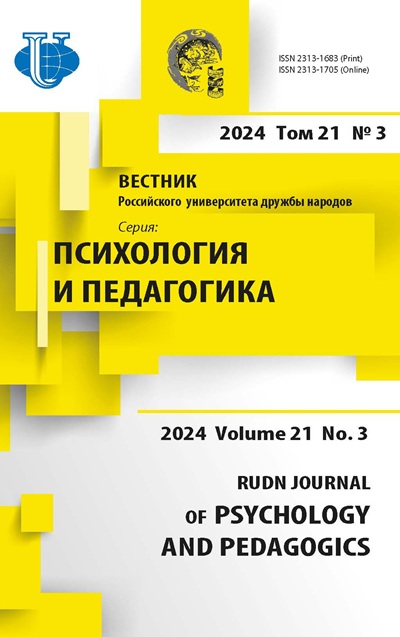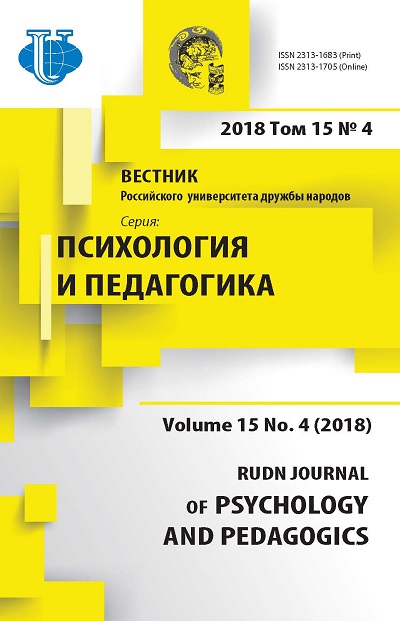Worries and Fears in the System of Attitudes to Personal Security of Patients with Cardiovascular Diseases
- Authors: Ivanov M.S1, Solodukhin A.V1,2, Pomeshkina S.A2, Seryy A.V1, Yanitsky M.S1, Gorbunova E.V2
-
Affiliations:
- Kemerovo State University
- Research Institute for Complex Issues of Cardiovascular Diseases
- Issue: Vol 15, No 4 (2018)
- Pages: 458-472
- Section: CLINICAL AND JURIDICAL PSYCHOLOGY
- URL: https://journals.rudn.ru/psychology-pedagogics/article/view/20374
- DOI: https://doi.org/10.22363/2313-1683-2018-15-4-458-472
Cite item
Full Text
Abstract
This paper presents the results of studying the psychological aspects of attitudes to personal security of patients with coronary artery disease (CAD) and heart defects. The research involved 40 patients aged 45 to 81 years (47.5 % male, 52.5 % female): 20 patients with ischemic heart disease with stable angina and 20 patients with acquired heart defects. In the course of the research conducted with the help of the techniques based on subjective scaling, the attitudes to personal security, including the sources of threats, the consequences of the realization of threats and the assessment of efforts on the counteraction to these threats, posing in the author’s theoretical model as the components of the system of the attitudes to personal security, have been studied. The results show that in the patients with heart diseases, the assessments for a variety of threats, the consequences of their realization and the efforts on the counteraction to them are significantly higher, than in the patients with CAD. In general, the estimates for all the parameters in the group of the patients with CAD were closer to the estimates of healthy people, obtained in the previous studies. In the patients with heart defects, characterized by a greater duration and disease severity, the results of the indicators of the attitudes to personal security, in general, are higher and less differentiated. The conclusion is made that the attitudes to personal security as a part of the system of the psychological attitudes in general, can act as a diagnostic criterion and the indicator of the efficiency of the adaptation in cardiovascular diseases and also can be an independent target of the correctional work in a psychological consultation and psychotherapy of the patients with cardiovascular diseases. In the conclusion the recommendations for the experts who are engaged in the psychological help to the patients with cardiovascular diseases in diagnostic and correctional work with the attitudes to personal security are formulated.
About the authors
Mikhail S Ivanov
Kemerovo State University
Author for correspondence.
Email: ivanov.mikail@gmail.com
Ph.D. in Psychology, Associate Professor of the Psychological Sciences Department, Kemerovo State University (Kemerovo, Russia).
6 Krasnaya St., Kemerovo, 650000, Russian FederationAnton V Solodukhin
Kemerovo State University; Research Institute for Complex Issues of Cardiovascular Diseases
Email: mein11@mail.ru
laboratory researcher, Laboratory of Neurovascular Pathology, Research Institute of Complex Problems of Cardiovascular Disease (Kemerovo, Russia).
6 Krasnaya St., Kemerovo, 650000, Russian Federation; 6 Sosnovyj Blvd, Kemerovo, 650002, Russian FederationSvetlana A Pomeshkina
Research Institute for Complex Issues of Cardiovascular Diseases
Email: swetlana.sap2@mail.ru
MD, Head of the Rehabilitation Laboratory of Research Institute of Complex Problems of Cardiovascular Disease (Kemerovo, Russia)
6 Sosnovyj Blvd, Kemerovo, 650002, Russian FederationAndrey V Seryy
Kemerovo State University
Email: avgrey@yahoo.com
Doctor Sc. of Psychology, Full Professor, Professor of the Psychological Sciences Department, Kemerovo State University (Kemerovo, Russia).
6 Krasnaya St., Kemerovo, 650000, Russian FederationMikhail S Yanitsky
Kemerovo State University
Email: direktorspi@kemsu.ru
Doctor Sc. of Psychology, Full Professor, Head of the Psychological Sciences Department, Director of the Socio-Psychological Institute of Kemerovo State University (Kemerovo, Russia).
6 Krasnaya St., Kemerovo, 650000, Russian FederationElena V Gorbunova
Research Institute for Complex Issues of Cardiovascular Diseases
Email: e.v.gorbunova@yandex.ru
MD, leading researcher of the Laboratory of Heart Rhythm Disturbances and Electrocardiostimulation, Research Institute of Complex Problems of Cardiovascular Disease, Head of the Polyclinic of the Kemerovo Regional Clinical Dispensary named after Academician L.S. Barbarash (Kemerovo, Russia).
6 Sosnovyj Blvd, Kemerovo, 650002, Russian FederationReferences
- Eremina, D.A., Kruglova, N.E., Shchelkova, O.Yu., & Yakovleva, M.V. (2014). Psikhologicheskiye osnovy povysheniya effektivnosti vosstanovitelnogo lecheniya bolnykh IBS posle koronarnogo shuntirovaniya. Vestnik SPbGU. Seriya 12. Sotsiologiya, (1), 54—68. (In Russ.)
- Hartfelder, D.V., Nikolaev, E.L., & Lasareva, E.Yu. (2014). Clinical and psychological personality traits in cardiovascular patients in connection with problems of prevention. Vestnik Kyrgyzskoкossiyskogo slavyanskogo Universiteta, (4), 60—62. (In Russ.)
- Hebert, E.A., Dugas, M.J., Tulloch, T.G., & Holowka, D.W. (2014). Positive beliefs about worry: A psychometric evaluation of the Why Worry-II. Personality and Individual Differences, 56, 3—8. doi: 10.1016/j.paid.2013.08.009
- Ivanov, M.S. (2015). Obespecheniye lichnoy bezopasnosti kak problema psikhologii zhiznennogo puti samorealizatsii i identichnosti lichnosti. Vestnik Kemerovskogo gosudarstvennogo universiteta, 3(63), 128—133. (In Russ.)
- Ivanov, M.S. (2017). Life Strategies of Personal Security. Proceedings of the III International Scientific and Practical Conference on Psychological Health of the Person: Life Resource and Life Potential (pp. 485—493). Krasnoyarsk: Professor V.F. Voino-Yasenetsky Krasnoyarsk State Medical University Publ. doi: 10.20333/2541-9315-2017-485-493
- Ivanov, M.S., Seryi, A.V., & Yanitskiy, M.S. (2018). Mobility as strategy of providing personal security in postmodern society. The European Proceedings of Social & Behavioural Sciences EpSBS. Vol. XXXV. doi: 10.15405/epsbs.2018.02.140
- Ivanov, M.S., & Yanitskiy, M.S. (2015). Otnosheniye k lichnoy bezopasnosti: ponyatiye, struktura, tsennostnaya variativnost. Psikhologiya otnosheniy v postneklassicheskoy paradigme (pp. 54—69). Belovo: KuzGTU Publ.; VelikoTаrnovo: St. Cyril and St.Methodius University of Veliko Tarnovo Publ.
- Katsarou, A.L., Triposkiadis, F., & Panagiotakos, D. (2013). Perceived stress and vascular disease: where are we now? Angiology, 64(7), 529—534. doi: 10.1177/0003319712458963
- Kostousov, A.G., Utyuganov, A.A., Yanitskiy, M.S., & Ivanov, M.S. (2017). Predstavleniya o bezopasnosti u kursantov voyennogo vuza i tsennostno-smyslovyye prediktory ikh sformirovannosti. Vestnik Novosibirskogo gosudarstvennogo pedagogicheskogo universiteta, (5), 37—54. (In Russ.)
- Krasnyanskaya, T.M. (2009.) Psikhologiya samoobespecheniya bezopasnosti. Pyatigorsk: PGLU Publ. 279 p. (In Russ.)
- Llera, S. J., & Newman, M. G. (2014). Rethinking the role of worry in generalized anxiety disorder: Evidence supporting a model of emotional contrast avoidance. Behavior Therapy, (45), 283—299. doi: 10.1016/j.beth.2013.12.011
- Lubinskaya, E.I. (2013). Sotsialno-ekonomicheskaya effektivnost mnogoprofilnoy reabilitatsii bolnykh ishemicheskoy boleznyu serdtsa, perenesshikh planovoye koronarnoye shuntirovaniye: Ph.D. in Medicine Thesis. Saint Petersburg.
- Niessen, C., & Jimmieson, N.L. (2016). Threat of resource loss: The role of self-regulation in adaptive task performance. Journal of Applied Psychology, 101(3), 450—462. doi: 10.1037/apl0000049
- Nikolayev, E.L., & Lazareva, E.Yu. (2014). Psikhosotsialnyye riski i resursy pri serdechno-sosudistykh zabolevaniyakh. Vestnik psikhiatrii i psikhologii Chuvashii, (10), 109—130. (In Russ.)
- Nikolayev, E.L., & Lazareva, E.Yu. (2015). Psikhoterapiya i psikhologicheskaya pomoshch bolnym serdechno-sosudistymi zabolevaniyami. Vestnik psikhiatrii i psikhologii Chuvashii, 11(1), 57—76.
- Pervichko E., Zinchenko Y., Martynov A. (2014). Epa-0581 — long-term integrative psychotherapy of anxiety disorders in mitral valve prolapse patients: the factors of mental health improvement. European Psychiatry, 29(1).
- Prins, J.M., Hospers, H.J., & van Breukelen, G.J.P. (2012). Self-regulatory processes mediate the intention-behavior relation for adherence and exercise behavior. Health Psychology, 31(6), 695—703.
- Shcherbatykh, Yu.V., & Ivleva, E.I. (1998). Psikhofiziologicheskiye i klinicheskiye aspekty strakha, trevogi i fobiy. Voronezh: Istoki Publ. 282 p. (In Russ.)
- Sidorov, K.R. (2013). Trevozhnost kak psikhologicheskiy fenomen. Vestnik Udmurtskogo universiteta. Seriya: Filosofiya. Psikhologiya. Pedagogika, (2), 42—52. (In Russ.)
- Sweeny, K., & Dooley, M.D. (2017).The surprising upsides of worry. Social and Personality Psychology Compass, (11). doi: 10.1111/spc3.12311
- Vasilenko, T.D. (2010). Rol sotsialno-psikhologicheskikh faktorov v izmenenii vremennoy organizatsii lichnosti v situatsii khronicheskogo somaticheskogo zabolevaniya. Vestnik Yaroslavskogo gosudarstvennogo universiteta im. P.G. Demidova. Ser. Gumanitarnyye nauki, (3), 75—79. (In Russ.)
- Vogt, J., Koster, E.H.W., & De Houwer, J. (2016). Safety First: Instrumentality for Reaching Safety Determines Attention Allocation Under Threat Emotion, 17(3), 528—537. doi: 10.1037/emo0000251
- White, C.N., Skokin, K., Carlos, B., & Weaver, A. (2016). Using decision models to decompose anxietyrelated bias in threat classification. Emotion, 16(2), 196—207. doi: 10.1037/emo0000109
















